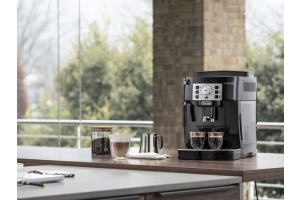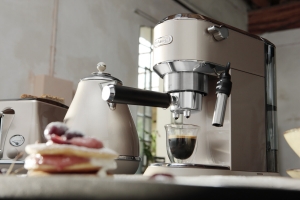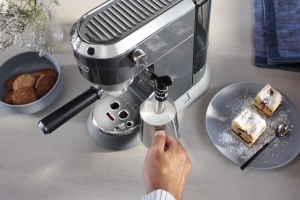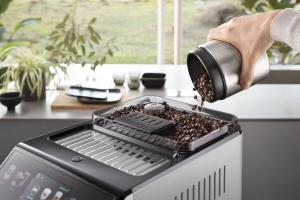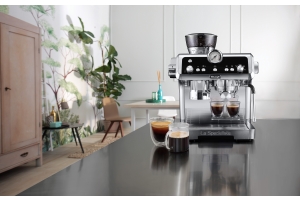How To Froth Milk: 3 Tools & Steps For The Perfect Froth

Foamed or frothed milk is used in many espresso drinks like cappuccino, latte, flat white, macchiato, whipped coffee, and many more hot beverages. If you have already invested in an espresso machine with a steam wand, then frothing milk is an easy step. The wand will steam your milk to yield a very enjoyable foam.
Most fully automatic espresso machines come with a steam wand that hangs off the side. This arm attachment forces steam into your milk, gently warming it with pressure, all while adding air into the milk, causing it to foam. What you need to get is a small metal pitcher for frothing milk, otherwise known as a milk-frothing pitcher or jug.
But, if you do not have an espresso machine with a steam wand, fret not. You can still become a barista in the comfort of your own home. All you need is a sturdy milk-frothing pitcher and one of the three tools below.
What are Milk-frothing Pitchers?

As mentioned earlier, milk frothing pitchers or jugs are one of the most important tools you need to make your own frothed milk at home. While frothing jugs come in different shapes and sizes to suit every coffee maker’s needs, they all have one thing in common: to evenly aerate milk to create the perfect texture and foam. When done right, frothed milk adds a creamy, airy mouthfeel to espresso-based drinks and more.
Even though you can use any type of container or jug to froth milk, choosing a frothing jug will most definitely make the process easier while producing more consistent results.
Take for instance, the De’Longhi Stainless Steel Milk Frothing Jug, made with polished stainless steel to ensure that your frothing pitcher is durable and dishwasher-safe. It is also designed with a thin spout so you can enjoy greater control and precision when pouring your frothed milk, allowing more room for creative latte art designs.
Best Tips to Froth Milk

Now that you know the importance of a good-quality milk frothing jug, here are some tips to help you get the best foam on your cuppa:
- Use fresh milk, as it is key to getting the best foam. Try to avoid using milk that has been in the fridge for weeks, as it might not foam.
- Consider switching to whole milk as it has the highest milk fat. You can also use non-dairy milk like oat milk. However, it may be more difficult to froth since it has lesser fat.
- Heat the milk to high temperatures to obtain the best results, ideally 65 degrees Celsius. You can measure the temperature using a food thermometer.
- Match the foam bubbles to your drink. Milk froth for latte typically has smaller bubbles and thicker consistency, whereas cappuccinos and macchiatos require bigger bubbles.
3 Handy Tools for Frothing Milk

Here are three tools you can try using to get airy, frothed milk.
Using a French Press
If you own a French press, then you can use this handy kitchen tool to make frothed milk. While this method works very well, it can sometimes yield inconsistent results, especially with non-dairy milk. For instance, if you are using oat milk, then you have to be careful not to over whip it.
Start by heating milk up to 60 to 80 degrees Celsius before pouring it into the French press. Put the lid on top without plunging it down. Be sure not to fill your French press to no more than halfway, so that there is still room for expansion. Once filled, simply pump the handle of the French press up and down rapidly. After pumping for 30 seconds to a minute, you should see the milk starts to froth and bubble. Stop the process by pressing down on the plunger once you are happy with the consistency. Voilà, you now have yourself a batch of frothed milk to top your cuppa.
Using a Whisk
Fret not if you do not have a French press, for you can still froth milk with a whisk or electric whisk!
Like with a French press, heat milk on the stove till it reaches between 60 degrees to 80 degrees Celsius. Pour the heated milk into the bowl (till halfway) once it has been heated and start whisking the milk rapidly. The milk should froth and bubble after a minute of whisking – this method takes longer than if you used a French press, so be patient if you do not see the milk frothing as quickly as expected. Continue whisking until you are happy with the consistency before pouring the milk froth into your hot beverage!
Using a Steam Wand
If you have an espresso machine at home and that comes with a steam wand, like in the De’Longhi La Specialista Arte, then you are in luck! Simply pour some cold milk into your stainless steel milk frothing jug and place it beneath the steam wand of your coffee machine. Insert the steam wand into the milk and ensure it goes below the surface before engaging the steam output dial on your coffee machine.
Keep the tip of your steam wand near the side of your milk frother jug, and you’ll start noticing a vortex created in your milk.
From here, you can then use your pitcher to gently move up and down and around the wand to incorporate air into your milk and break up any larger bubbles that have formed. You should notice the bubbles in your frothing milk get progressively smaller.
Once your milk has reached the desired consistency (it should be akin to melted ice cream), close the dial and remove your stainless steel milk frothing jug from the coffee machine’s steam wand. Pour the frothed milk immediately into your coffee, leaving excess if you intend to add in a little latte art!
Shop De’Longhi for Milk Frothing Tools and Coffee Essentials
Whether it is milk frothing jugs or coffee essentials, De’Longhi Malaysia has all things coffee-related to help enrich your coffee-making experience. Shop our extensive line-up of barista tools, premium coffee beans, and coffee machines today!
